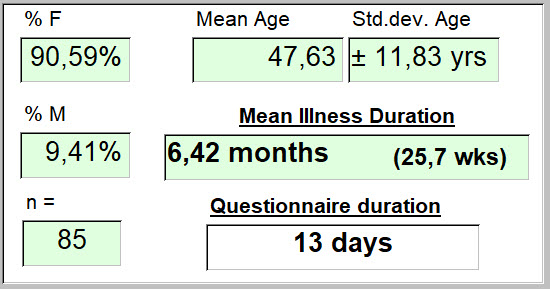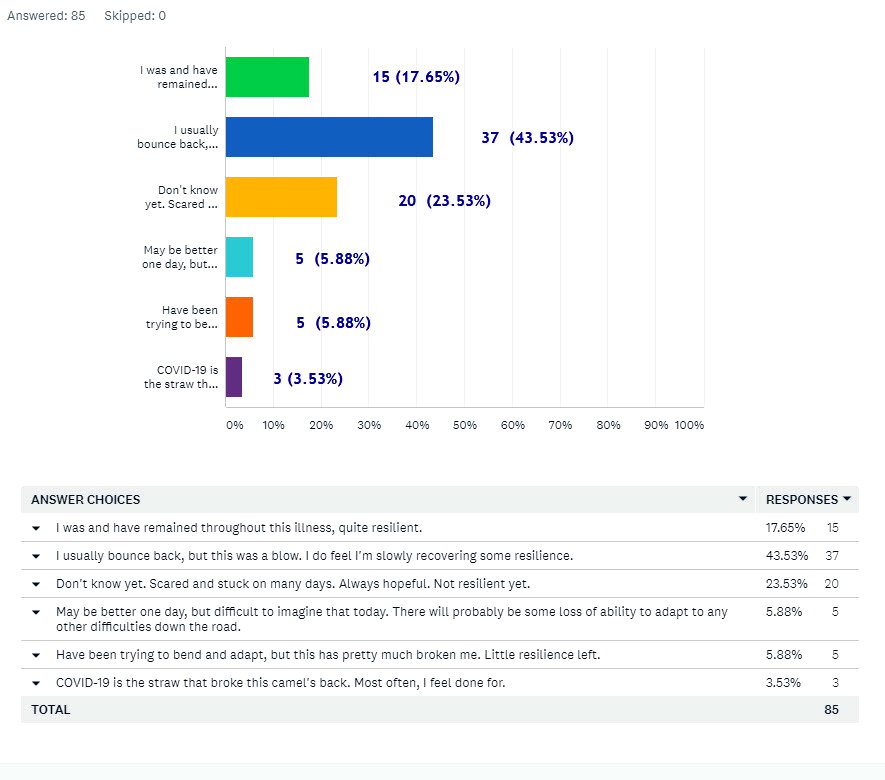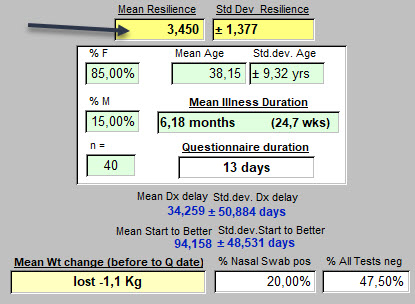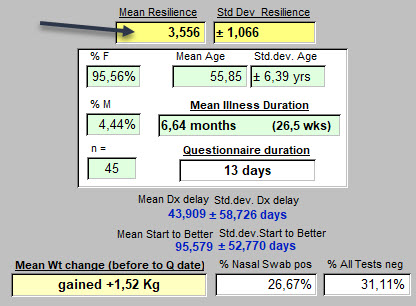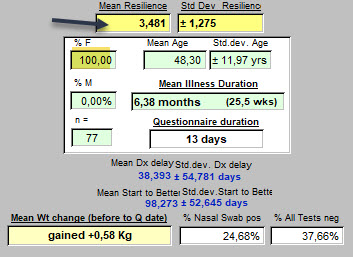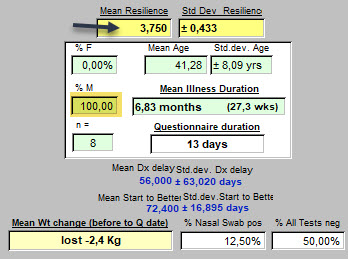Lesson 5: Fostering resilience
Here's how the topic was introduced in the questionnaire.
"This particular viral illness, at whatever level of severity, is potentially likely to be traumatic and possibly tragic. In response, if one is to recover one's individual humanity, that requires resilience. It requires an ability to adapt.
If you are currently still just getting through it, you will likely one day look back. And with an eye towards this period of illness, assess what you did, the skills you developed, and how well they served you for self care. They might even serve again in other difficult times, if these components of resilience were mastered: A blend of grit, hardness, optimism, mindfulness, asking for help when needed, and living towards a goal may contribute to survival but also resilience. Bending before breaking. How well have you maintained and improved your resilience?"
SIx suggested responses were :
Without showing the numbers above, these were assigned a value, from top to bottom, of 5, 4, 3, 2, 1, 0.
---------
What follows represents 85 responses. No one skipped this question.
Most were female, with a mean age of 47.6 years on the 13th day the questionnaire had been active.
They had been ill 26 weeks on average.
For the 85 respondents, from when they first developed symptoms to day of diagnosis (when there was one) was 39,6 days on average, and from start of symptoms to when they began to feel better was a very variable 95 days (13.6 wks), though only 35 of 85 had attained this "felt better" result at time of responding.
The response frequencies for the responses as shown above are seen below :
- Essentially unchanged levels of resilience were reported by approximately 18%.
- 44% responded that "bouncing back" was difficult, but slow progress was being made.
- About a quarter of respondents were uncertain about progress and not yet resilient - 24%.
- And grouping the last three answers, 13 respondents (just over 15%), found little or no resilience throughout their day. Caught between a rock and a hard place.
These results permitted calculation of a mean resilience level at the time the questionnaire was completed:
This value is above the midpoint of 2.5, suggesting that a positive outlook for recovery was in evidence for most respondents. That result, even if this illness has "been a blow."
---------
Some subgroups of these responses were analyzed.
The 85 were grouped by age <= 49 and >49 years.
Resilience is likely to be affected by multiple aspects or contributors to this illness, lived each day.
Here we include along with mean levels of resilience: results of tests, duration of illness, and stability of body weight, gender split and mean delay of diagnosis.
First, those with age <= 49 years :
Second, those age > 49 years :
One can notice differences for many of the variables presented. These may or may not be significant.
But to stay on topic: Is the slightly higher mean resilience seen in the older group (mean 56 yrs) distinct from that of the younger group (mean 38 yrs) ?
age > 49: n = 45 mean = 3.556 ± 1.066
age <=49: n = 40 mean = 3.450 ± 1.377
by Student's t-test, t = 0.3992, df = 83, p = 0.6908 (NS)
And that "NS" means no significant difference in mean resilience of the older and younger individuals with "long-term" COVID-19. The degree of "bounce back" discovered in the overall group of 85 respondents is not different when re-grouped by age. And one might have guessed that, even without the statistical challenge of this idea.
What about gender differences affecting perceived resilience?
This is also a good place to mention that these are personal, i.e., subjective assessments.
It assumes an ability to distinguish the possible choices one from the other, and find one that is the best expression of the respondent's actual level of "bounce back" or resilience when answering.
We did not apply a "resilience meter" to each person. Think of a pulse oximeter and the oxygen saturation and heart rate numbers that it presents. While such numbers seem ultimately objective, correct interpretation requires more than just a rudimentary understanding of physiology and the various illnesses that impact the readings, sometimes simultaneously. But it does measure something, anf give a number to read off and interpret.
So let's apply our subjective "resilience meter" to male and female respondents. Do their assessments differ?
Lady's first ...
Then the men ...
One can notice in passing other differences: weight gain vs weight loss. Differences in test outcomes and delay of diagnosis for instance.
The most important to begin with, is the number of femaile (77) and male (8) respondents.
Is that a large enough sample to define that apparent increased resilience in men as real, or not?
females: n = 77 mean = 3.481 ± 1.275
males: n = 8 mean = 3.750 ± 0.433
by Student's t-test, t = 0.5904, df = 83, p = 0.5565 (NS)
So this statistical comparison of means, just saved us getting into an argument of the sexes about who is "bouncing back" and who isn't. The apparent difference is "NS," not significant.
So in this preliminary report, it may be enough to say that the 85 who responded, and who identify themselves with a diagnosis (or situation at least) of "long-term" COVID-19, have taken, and continue to take, a beating. Just like a tennis ball that has been batted back and forth eventually loses some bounce, they have too.
And that response selected by the majority ends with: "... I'm slowly recovering some resilience."
A small minority (3.5%) feel permanently broken, and "done for."
A very important thing to emphasize. It was bad. It's getting better. That news is worth sharing.
And that's not the doctor's or family's opinion. That's straight from the patient. Of all ages and not different for women and men. Not the incidence: women get this illness more frequently than men as you probably know. But the challenge to "bouncing back," and the proabability of eventually getting there, seems universal.
----------
Almost as an aside, the difference seen here in weight gain or loss by gender, may have caught your attention. Are these differences distinct?
Here's a last statistical challenge of the results obtained so far.
Weight data were complete (before and after weights provided) in 78 of 85 respondents.
females: n = 70 mean = +0.577 ± 5.392 Kg gained
males: n = 8 mean = -2.375 ± 4.091 Kg lost
by Student's t-test, t = 1.4965, df = 76, p = 0.1387 (NS)
And?
Well the statistical purist might say that because the p value is greater than 0.05, that the hypothesis that the weights are different in women and men with this illness, cannot be sustained.
But that p value is suggesting that there are only 14 chances out of 100 that that apparent differences in change of weight by gender, are not a real finding. Of course, only 8 men on that side of the comparison weakens that suggestion. So we put this aside for a while until the number of responses increases. But it's not forgotten.
-----------
So. Resilience: What contributes to it?
What can be done to increase the "bounce back" when it's taken a beating, as is clear from the responses. Again, only 17.7% shared that they thought they were doing Ok with resilience.
Where to now?
Hopefully, our small data set reported in preliminary fashion here today, has started some thinking.
But others have been thinking about this before us (Thank goodness!).
The levels of resilience presented here, for those faced with recovery from "long-term" COVID-19, are individual levels. We put them together for comparisons between these individuals, who were kind enough to respond and provide thoughtful answers.
But beyond the individual, there is resilience that exists (or should) at a community level. Also at an existential level.
Let's call on : Abby R. Rosenberg, MD, MS, MA of the Palliative Care and Resilience Lab, Center
for Clinical and Translational Research, in Seattle, WA, USA ... to be our guide.
To help shape not only our ideas about resilience, but surround it with inferences about how to get some of that commodity, as recovery proceeds. One can find other sources of information. This one is a good place to start.
And do what you can, to keep these good answers coming. Please share the questionnaire (link below) with those who are also, waiting for resilience to bounce back in their direction.
This was Lesson 5.
Here are those that came before, also grown from the seeds of these terrific responses, if you missed them:
Lesson 1: Test results - how uncertainty changes our lives
Lesson 1a: Test results - adding light as well as heat. A concise reporting of test results. (77 respondents when written).
Lesson 2: So what about that weight gain?
Lesson 3: Effective emotional support - where shall we turn?
Lesson 4: "Long-term" COVID-19 - How scary is that?
<<<<<<<<< Introduction to the Questionnaire
Direct link to the questionnaire >>>>>>>>>
A découvrir aussi
- The CallingCOVID.com Questionnaire - Introduction
- Lesson 1: Test results - how uncertainty changes our lives
- BIO: Principle Investigator


